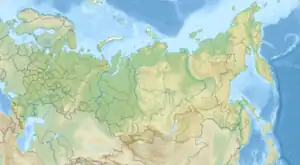| Ob Plateau | |
|---|---|
| Приобское плато | |
 NASA satellite image showing the straight and parallel ravines of glacial origin | |
| Highest point | |
| Peak | Unnamed |
| Elevation | 321 m (1,053 ft)[1] |
| Geography | |
 | |
| Country | Russia |
| Federal subject | Altai Krai, Novosibirsk Oblast |
| Range coordinates | 53°30′N 81°0′E / 53.500°N 81.000°E |
| Parent range | West Siberian Plain |
| Geology | |
| Age of rock | Quaternary |
| Type of rock | Loess-like loam, sand |
The Ob Plateau (Russian: Приобское плато, Priobskoye Plato), is one of the great plateaus of Siberia. Administratively it falls within Altai Krai and Novosibirsk Oblast, Siberian Federal District, Russia. The plateau is named after the Ob River and is part of its basin.[2][3]
Most of the territory of the plateau has been agriculturally developed, yielding grain crops as well as industrial crops.[4]
Geography
The Ob Plateau is located in Altai Krai and Novosibirsk Oblast at the southern edge of the West Siberian Plain. It extends roughly to the north of the foothills of the Altai Mountains along the left bank of the north-flowing Ob River. To the west it descends gradually to the Kulunda Plain.[2][3]
The average height of the Ob Plateau surface is between 250 meters (820 ft) and 260 meters (850 ft), reaching a maximum height of 321 metres (1,053 ft) at an unnamed summit. The plateau is dissected by wide ravines of glacial origin, about 20 kilometers (12 mi) in width and between 40 meters (130 ft) a 100 meters (330 ft) deep, stretching parallel to each other in a roughly northeast to southwest direction. Chernozem soils predominate in the open steppe spaces of the plateau.[4][5] [6]
Hydrography
Some of the main rivers of the plateau are the Aley, Barnaulka, Kulunda, Burla, Karasuk, Bagan and Kasmala among others. Lakes Bolshoye Gorkoye and Maloye Gorkoye have briny waters.[4][3]
 Ob Plateau area ONC map section. |
Flora
There are forests made up mostly of birch in the ravines, as well as remnants of coniferous taiga in higher areas. Wetlands and lakes are common in the river valleys cutting across the plateau.[4]
See also
References
- ↑ Алтайский край, Географическое положение - К.В. Григоричевым
- 1 2 Google Earth
- 1 2 3 Geographical position, geological structure and surface topography of the south of Western Siberia (in Russian)
- 1 2 3 4 Приобское плато; Great Soviet Encyclopedia in 30 vols. — Ch. ed. A.M. Prokhorov. - 3rd ed. - M. Soviet Encyclopedia, 1969-1978. (in Russian)
- ↑ "M-44 Topographic Chart (in Russian)". Retrieved 2 July 2022.
- ↑ "N-44 Topographic Chart (in Russian)". Retrieved 2 July 2022.
External links
 Media related to Ob Plateau at Wikimedia Commons
Media related to Ob Plateau at Wikimedia Commons- Федеральное государственное автономное образовательное учреждение